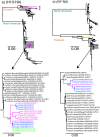The recent establishment of North American H10 lineage influenza viruses in Australian wild waterfowl and the evolution of Australian avian influenza viruses
- PMID: 23864623
- PMCID: PMC3753992
- DOI: 10.1128/JVI.03437-12
The recent establishment of North American H10 lineage influenza viruses in Australian wild waterfowl and the evolution of Australian avian influenza viruses
Abstract
Influenza A H10N7 virus with a hemagglutinin gene of North American origin was detected in Australian chickens and poultry abattoir workers in New South Wales, Australia, in 2010 and in chickens in Queensland, Australia, on a mixed chicken and domestic duck farm in 2012. We investigated their genomic origins by sequencing full and partial genomes of H10 viruses isolated from wild aquatic birds and poultry in Australia and analyzed them with all available avian influenza virus sequences from Oceania and representative viruses from North America and Eurasia. Our analysis showed that the H10N7 viruses isolated from poultry were similar to those that have been circulating since 2009 in Australian aquatic birds and that their initial transmission into Australia occurred during 2007 and 2008. The H10 viruses that appear to have developed endemicity in Australian wild aquatic birds were derived from several viruses circulating in waterfowl along various flyways. Their hemagglutinin gene was derived from aquatic birds in the western states of the United States, whereas the neuraminidase was closely related to that from viruses previously detected in waterfowl in Japan. The remaining genes were derived from Eurasian avian influenza virus lineages. Our analysis of virological data spanning 40 years in Oceania indicates that the long-term evolutionary dynamics of avian influenza viruses in Australia may be determined by climatic changes. The introduction and long-term persistence of avian influenza virus lineages were observed during periods with increased rainfall, whereas bottlenecks and extinction were observed during phases of widespread decreases in rainfall. These results extend our understanding of factors affecting the dynamics of avian influenza and provide important considerations for surveillance and disease control strategies.
Figures




References
-
- Alexander DJ. 2000. A review of avian influenza in different bird species. Vet. Microbiol. 74:3–13 - PubMed
-
- Peiris JSM. 2009. Avian influenza viruses in humans. Rev. Sci. Tech. 28:161–174 - PubMed
-
- Selleck PW, Gleeson L, Hooper P, Westbury H, Hansson E. 1997. Identification and characterisation of an H7N3 influenza A virus from an outbreak of virulent avian influenza in Victoria. Aust. Vet. J. 75:289–292 - PubMed
-
- Department of Primary Industries 15 November 2012. Avian influenza confirmed at Hunter Valley egg farm. Media release. Department of Primary Industries, New South Wales Government, Sydney, NSW, Australia: www.dpi.nsw.gov.au/aboutus/news/all
Publication types
MeSH terms
Substances
Grants and funding
LinkOut - more resources
Full Text Sources
Other Literature Sources
Medical

